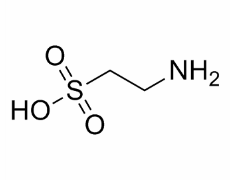All AbMole products are for research use only, cannot be used for human consumption.

Taurine, or 2-aminoethanesulfonic acid, is an organic acid. It is a major constituent of bile and can be found in the lower intestine and, in small amounts, in the tissues of many animals, including humans. Taurine is a derivative of the sulfur-containing (sulfhydryl) amino acid cysteine. Taurine is one of the few known naturally occurring sulfonic acids. Taurine has the ability to activate autophagy in adipocytes. Taurine is one of the most abundant amino acids in the brain and spinal cord, leukocytes, heart and muscle cells, the retina, and indeed almost every tissue throughout the body.
| Molecular Weight | 125.15 |
| Formula | C2H7NO3S |
| CAS Number | 107-35-7 |
| Solubility (25°C) | Water 20 mg/mL |
| Storage |
Powder -20°C 3 years ; 4°C 2 years In solvent -80°C 6 months ; -20°C 1 month |
[1] Tawar Qaradakhi, et al. The Anti-Inflammatory Effect of Taurine on Cardiovascular Disease
| Related Metabolite/Endogenous Metabolite Products |
|---|
| D-Tryptophan
D-Tryptophan is the D-isomer of tryptophan, as a non-protein active amino acid, has special physiological properties, can be used as additives, plant growth agents, etc. In the pharmaceutical industry, it is mainly used in the synthesis of various polypeptides, instead of L-tryptophan to extend the peptide half-life. |
| Arachidonic acid sodium salt
Arachidonic acid sodium salt (Sodium Arachidonate) is a polyunsaturated omega-6 fatty acid and a major constituent of biomembranes. Arachidonic acid sodium salt also acts as the substrate for various lipid mediators, such as prostaglandins (PGs). |
| trans-Vaccenic acid
trans-Vaccenic acid is a naturally occurring trans fatty acid (TFA). trans-Vaccenic acid is a precursor for the synthesis of saturated fatty acid in the rumen and of conjugated Linoleic acid (CLA) at the tissue level. trans-Vaccenic acid inhibits nasopharyngeal carcinoma (NPC) cell growth and induces apoptosis through the inhibition of Bad/Akt phosphorylation. |
| Mead acid
Mead acid (5,8,11-Eicosatrienoic acid) is an unsaturated (Omega-9) fatty acid. |
| p-Cresol glucuronide
p-Cresol glucuronide is a metabolite of p-cresol, it is a prototype protein-bound uremic toxin. |
All AbMole products are for research use only, cannot be used for human consumption or veterinary use. We do not provide products or services to individuals. Please comply with the intended use and do not use AbMole products for any other purpose.


Products are for research use only. Not for human use. We do not sell to patients.
© Copyright 2010-2024 AbMole BioScience. All Rights Reserved.
